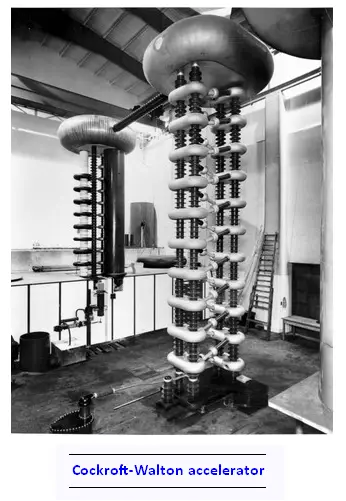Nuclear Physics
The nucleus
Radioactivity
Applications
Particle accelerators
© The scientific sentence. 2010
|
simple_accelerator.png
Nuclear Physics &
Particle Physics
Particle accelerators
Electrostatic Accelerators
Cockcroft and Walton accelerator
Cockcroft and Walton accelerator

The Cockcroft–Walton (CW) generator, or multiplier, is an electric circuit that generates a high DC voltage from a low-voltage AC or pulsing DC input.
The Cockcroft Walton accelerator performed the first nuclear disintegration
by artificial means. Cockcroft and Walton accelerated protons
up to voltage of 700kV and bombarded them onto a target
of lithium producing the reaction:
11P + 73Li ->
42He + 42He
This was the first experiment to show that one element (lithium) could be
artificially transformed or transmuted into another element (helium).
The Cockcroft–Walton accelerator is a multiplier. To obtain more than about
200 kV of accelerating voltage, it is necessary to use one or more
stages of voltage-doubling circuits. The first such device was built by J. D.
Cockcroft and E. T. S. Walton in 1932 and was used for the first transmutation
experiments with artificially accelerated particles (protons).
Cockcroft-Walton accelerators are still widely used today, sometimes
as injectors to much larger accelerators.
|
|